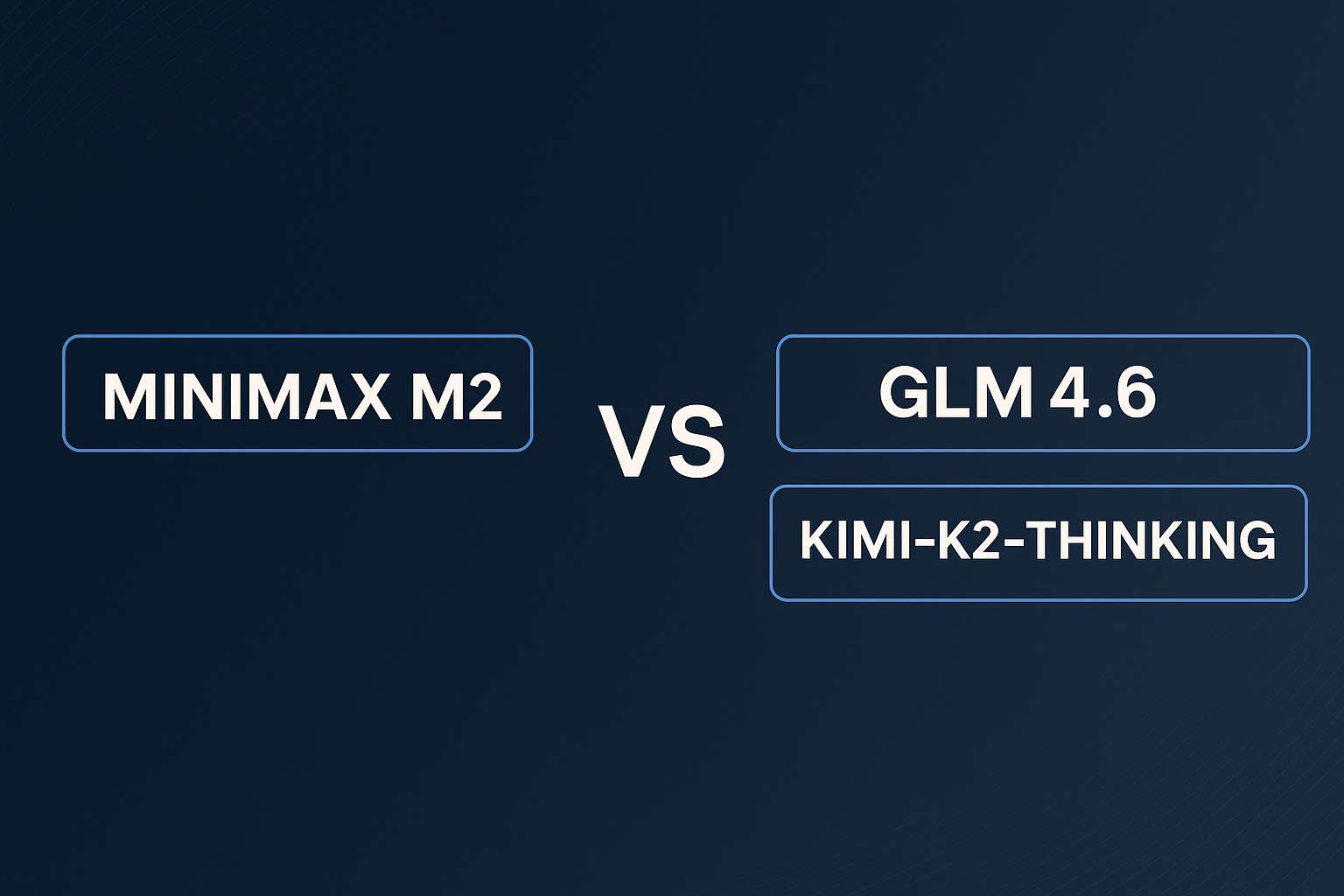MiniMax M2 vs GLM 4.6 vs Kimi-K2-Thinking — A Complete Comparison
MiniMax M2 vs GLM 4.6 vs Kimi-K2-Thinking — A Complete Comparison

Introduction
The large language model (LLM) race is heating up fast — and three models are leading the conversation: MiniMax M2, GLM 4.6, and Kimi-K2-Thinking.
Each has its own architecture, context length, and application focus. In this article, I’ll walk you through how they differ, where they shine, and which one might be best for your use case.
1. MiniMax M2 Overview
MiniMax M2 is an upgraded model following MiniMax M1 — the open-weight model famous for its 1 million-token context window and efficient training.
While official public details of M2 are still limited, most assume it inherits and enhances M1’s architecture.
Key Highlights:
- Ultra-long context (up to 1M tokens) — ideal for long documents, books, or codebases.
- Open-weight license (Apache 2.0) — suitable for on-premise or private hosting.
- Efficient inference — hybrid attention + MoE design improves cost-performance.
- Use cases: research summarization, document retrieval, or massive multi-turn chats.
Potential Drawbacks:
- High GPU demand (memory heavy).
- Limited ecosystem and community tools so far.
2. GLM 4.6 Overview
GLM 4.6 is developed by Zhipu AI (Z.AI) — known for balancing reasoning, code generation, and “agentic” capabilities (tools, APIs, retrievals).
Compared to 4.5, version 4.6 has significantly improved tool use, coding, and response consistency.
Key Highlights:
- Strong reasoning and tool-use support — great for agent-based systems.
- Balanced general model — good for chat, analysis, and multi-turn reasoning.
- Improved accuracy and speed compared to earlier versions.
- Stable API and growing developer ecosystem.
Potential Drawbacks:
- Not open-weight (requires API or license).
- Context window smaller than MiniMax M2 (~128K tokens typical).
3. Kimi-K2-Thinking Overview
Kimi-K2-Thinking is Moonshot AI’s latest open model, built on a Mixture of Experts (MoE) structure.
It contains around 1 trillion total parameters but activates about 32 billion per inference — making it both powerful and efficient.
Key Highlights:
- Large-scale MoE architecture — competitive with GPT-4-level reasoning.
- 128K token context — handles long documents efficiently.
- OpenAI-compatible API — integrates easily with existing SDKs.
- Superior coding and reasoning ability in public benchmarks.
Potential Drawbacks:
- Requires strong hardware for self-hosting.
- Ecosystem still growing, fewer third-party integrations.
4. Feature Comparison Table
| Model | Context Window | Architecture | License | Best Use Case | Drawbacks |
|---|---|---|---|---|---|
| MiniMax M2 | ~1M tokens | Hybrid + MoE | Open (Apache 2.0) | Long documents, multi-file context | GPU heavy, smaller community |
| GLM 4.6 | ~128K tokens | Transformer | Proprietary / API | Tool-use, coding, chatbots | Not open, limited customization |
| Kimi-K2-Thinking | ~128K tokens | MoE (1T total, 32B active) | Semi-open | Reasoning, code generation | Newer ecosystem, costly for self-host |
5. Model Strengths in Practice
- MiniMax M2 → Best for long-context analysis and document reasoning.
- GLM 4.6 → Best for stable tool-integration and production-ready applications.
- Kimi-K2-Thinking → Best for top-tier reasoning and large-scale AI projects.
If you work with long research papers, books, or logs → choose MiniMax M2.
If you build chatbots or tool-using agents → choose GLM 4.6.
If you want maximum reasoning performance → Kimi-K2-Thinking is a clear win.
6. My Take as a Developer
After testing them briefly:
- MiniMax M2 impressed me with massive input capability, though it’s hardware-hungry.
- GLM 4.6 feels balanced — stable responses, good for production APIs.
- Kimi-K2-Thinking felt smart — it handled complex logic and code reasoning better than expected.
Overall, each model has a clear positioning. It’s less about “which is best” and more about which fits your workload.
FAQ
Q1: Can I run these models locally?
Yes, MiniMax M2 (open-weight) and Kimi-K2 can be self-hosted with multi-GPU setups. GLM 4.6 requires access via API.
Q2: Which one is the most cost-efficient?
Kimi-K2-Thinking is often cheaper per token. MiniMax is efficient but demands large GPUs; GLM pricing depends on API usage.
Q3: What’s the best model for long-document reasoning?
MiniMax M2 — thanks to its million-token window — is ideal for large texts or research papers.
Q4: Which model has the best developer ecosystem?
GLM 4.6 currently leads in documentation and community support. Kimi-K2 is growing fast.
Q5: How about coding tasks and debugging?
Kimi-K2-Thinking shows the strongest performance in reasoning and code refactoring, followed by GLM 4.6.
Q6: Is Kimi-K2 really open-source?
Partially. Moonshot has released weights and an API, but the “Thinking” variant remains hosted-only for now.
🚀 Final Thoughts
The AI model landscape in 2025 is no longer just GPT-4 vs Claude.
MiniMax M2, GLM 4.6, and Kimi-K2-Thinking each represent different directions — ultra-long context, robust tool-use, and deep reasoning.
Your best pick depends entirely on your goals, infrastructure, and budget.